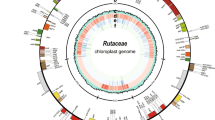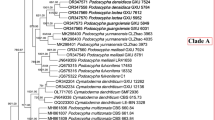Abstract
Availability of comprehensive phylogenetic tree for flowering plants which includes many of the economically important crops and trees is one of the essential requirements of plant biologists for diverse applications. It is the first study on the use of chloroplast genome of 3265 Angiosperm taxa to identify evolutionary relationships among the plant species. Sixty genes from chloroplast genome was concatenated and utilized to generate the phylogenetic tree. Overall the phylogeny was in correspondence with Angiosperm Phylogeny Group (APG) IV classification with very few taxa occupying incongruous position either due to ambiguous taxonomy or incorrect identification. Simple sequence repeats (SSRs) were identified from almost all the taxa indicating the possibility of their use in various genetic analyses. Large proportion (95.6%) of A/T mononucleotide was recorded while the di, tri, tetra, penta and hexanucleotide amounted to less than 5%. Ambiguity of the taxonomic status of Tectona grandis L.f was assessed by comparing the chloroplast genome with closely related Lamiaceae members through nucleotide diversity and contraction/expansion of inverted repeat regions. Although the gene content was highly conserved, structural changes in the genome was evident. Phylogenetic analysis suggested that Tectona could qualify for a subfamily Tectonoideae. Nucleotide diversity in intergenic and genic sequences revealed prominent hyper-variable regions such as, rps16-trnQ, atpH-atpI, psc4-psbJ, ndhF, rpl32 and ycf1 which have high potential in DNA barcoding applications.


Similar content being viewed by others
References
Ali M 2019 Comparative chloroplast genomic analyses revealed extensive genomic arrangement in some core and non-core caryophyllales. Bangladesh j. Plant Taxon. 26 106–117
Amiryousefi A, Hyvonen J and Poczai P 2018 IRscope: an online program to visualize the junction sites of chloroplast genomes. Bioinformatics 34 3030–3031
Bi Y, Zhang M, Xue J, Dong R, Du Y and Zhang X 2018 Chloroplast genomic resources for phylogeny and DNA barcoding: a case study on Fritillaria. Sci. Rep. 8 1184
Byrne M and Hankinson M 2012 Testing the variability of chloroplast sequences for plant phylogeography. Aust. j. Bot. 60 569–574
Carbonell-Caballero J, Alonso R, Ibañez V, Terol J, Talon M and Dopazo J 2015 A phylogenetic analysis of 34 chloroplast genomes elucidates the relationships between wild and domestic species within the genus Citrus. Mol. Biol. Evol. 32 2015–2035
Cheon KS, Kim KA, Kwak M, Lee B and Yoo KO 2019 The complete chloroplast genome sequences of four Viola species (Violaceae) and comparative analyses with its congeneric species. PLoS One 14 e0214162
Daniell H, Lin CS, Yu M and Chang WJ 2016 Chloroplast genomes: diversity, evolution, and applications in genetic engineering. Genome Biol. 17 134
Dong WP, Liu J, Yu J, Wang L and Zhou SL 2012 Highly variable chloroplast markers for evaluating plant phylogeny at low taxonomic levels and for DNA barcoding. PLoS One 7 e35071
Frazer KA, Pachter L, Poliakov A, Rubin EM and Dubchak I 2004 VISTA: computational tools for comparative genomics. Nucl. Acids Res. 32 273–279
Gitzendanner MA, Soltis PS and Wong GKS 2018 Plastid phylogenomic analysis of green plants: a billion years of evolutionary history. Am. j. Bot. 105 291–301
Guyeux C, Charr JC, Tran HTM, Furtado A, Henry RJ, Crouzillat D, Guyot R and Hamon P 2019 Evaluation of chloroplast genome annotation tools and application to analysis of the evolution of coffee species. PLoS One 14 e0216347
Hall T, Biosciences I and Carlsbad C 2011 BioEdit: An important software for molecular biology. GERF Bull. Biosci. 2 60–61
Jansen RK, Raubeson LA, Boore JL, dePamphilis CW, Chumley TW, et al. 2005 Methods for obtaining and analyzing whole chloroplast genome sequences. Methods Enzymol. 395 348–384
Katoh K and Standley DM 2013 MAFFT multiple sequence alignment software version 7: improvements in performance and usability. Mol. Biol. Evol. 30 772–780
Kim HM, Oh SH, Bhandari GS, Kim CS and Park CW 2014 DNA barcoding of Orchidaceae in Korea. Mol. Ecol. Res. 14 499–507
Könyves K, Bilsborrow J, David J and Culham A 2018 The complete chloroplast genome of Narcissus poeticus L. (Amaryllidaceae: Amaryllidoideae). Mitochondrial DNA B Resour. 3 1137–1138
Kumar S, Stecher G, Li M, Knyaz C and Tamura K 2018 MEGA X: Molecular evolutionary genetics analysis across computing platforms. Mol. Biol. Evol. 35 1547–1549
Lee J, Kim SY, Park SH and Ali MA 2013 Molecular phylogenetic relationships among members of the Phytolaccaceae sensu lato inferred from internal transcribed spacer sequences of nuclear ribosomal DNA. Genet. Mol. Res. 12 4515–4525
Letunic I and Bork P 2019 Interactive Tree Of Life (iTOL) v4: recent updates and new developments. Nucl. Acids Res. 47 W256–W259
Li B, Cantino PD, Olmstead RG, Bramley GLC, Xiang CL, Ma ZH, Tan YH and Zhang DX 2016 A large-scale chloroplast phylogeny of the Lamiaceae sheds new light on its subfamilial classification. Sci. Rep. 6 34343
Li B and Olmstead R 2017 Two new subfamilies in Lamiaceae. Phytotaxa 313 222–226
Li W, Liu Y, Yang Y, Xie X, Lu Y, Yang Z, Jin X, Dong W and Suo Z 2018 Interspecific chloroplast genome sequence diversity and genomic resources in Diospyros. BMC Plant Biol. 18 210
Li ZH, Ma X, Wang DY, Li YX, Wang CW and Jin XH 2019 Evolution of plastid genomes of Holcoglossum (Orchidaceae) with recent radiation. BMC Evol. Biol. 19 63
Lu X, Adedze YMN, Chofong GN, Gandeka M, Deng Z, Teng L, Zhang X, Sun G, Si L and Li W 2018 Identification of high-efficiency SSR markers for assessing watermelon genetic purity. J. Genet. 97 1295–1306
Martin GE, Rousseau-Gueutin M, Cordonnier S, Lima O, Michon-Coudouel S, Naquin D, De Carvalho JF, Ainouche M, Salmon A and Ainouche A 2014 The first complete chloroplast genome of the Genistoid legume Lupinus luteus: evidence for a novel major lineage-specific rearrangement and new insights regarding plastome evolution in the legume family. Ann. Bot. 113 1197–1210
Nock CJ, Hardner CM, Montenegro JD, Termizi AA, Hayashi S, Playford J, Edwards D and Batley J 2019 Wild origins of Macadamia domestication identified through intraspecific chloroplast genome sequencing. Front. Plant Sci. 10 334
Oldenburg DJ and Bendich AJ 2015 DNA maintenance in plastids and mitochondria of plants. Front. Plant Sci. 6 883
Park I, Yang S, Kim WJ, Song JH, Lee HS, Lee HO, Lee JH, Ahn SN and Moon BC 2019 Sequencing and comparative analysis of the chloroplast genome of Angelica polymorpha and the development of a novel indel marker for species identification. Molecules 24 1038
Raveendar S, Jeon YA, Lee JR, Lee GA, Lee KJ and Cho GT 2015 The complete chloroplast genome sequence of Korean landrace “Subicho” pepper (Capsicum annuum var. annuum). Plant Breed. Biotech. 3 88–94
Rozas J, Ferrer-Mata A, Sánchez-Del-Barri JC, Guirao-Rico S, Librado P, Ramos-Onsins SE and Sánchez-Gracia A 2017 DnaSP v6: DNA sequence polymorphism analysis of large datasets. Mol. Biol. Evol. 34 299–302
Shukla N, Kuntal H, Shanker A and Sharma SN 2018 Mining and analysis of simple sequence repeats in the chloroplast genomes of genus Vigna. Biotech. Res. Innov. 2 9–18
Soltis PS, Folk RA and Soltis DE 2019 Darwin review: angiosperm phylogeny and evolutionary radiations. Proc. r. Soc. Lond. B Biol. Sci. 286 20190099
Swofford DL 2002 PAUP*. Phylogenetic Analysis Using Parsimony (*and Other Methods) Version 4.0b10. Sinauer Associates, Sunderland, Mass
Takahashi D, Sakaguchi S, Isagi Y and Setoguchi H 2018 Comparative chloroplast genomics of series Sakawanum in genus Asarum (Aristolochiaceae) to develop single nucleotide polymorphisms (SNPs) and simple sequence repeat (SSR) markers. J. for. Res. 23 387–392
Thode VA and Lohmann LG 2019 Comparative chloroplast genomics at low taxonomic levels: a case study using Amphilophium (Bignonieae, Bignoniaceae). Front. Plant Sci. 10 796
Wagstaff SJ and Olmstead RG 1997 Phylogeny of Labiatae and Verbenaceae inferred from rbcL sequences. Syst. Bot. 22 165–179
Walker JF 2018 Novel Phylogenomic Methods for Uncovering the Evolutionary History of the Hyperdiverse Clade Caryophyllales. Thesis submitted for Doctor of Philosophy (Ecology and Evolutionary Biology), University of Michigan pp 202
Wang DS, Wang ZS, Kang XY and Zhang JG 2019 Genetic analysis of admixture and hybrid patterns of Populus hopeiensis and P. tomentosa. Sci. Rep. 9 4821
Wang W, Chen S and Zhang X 2018 Whole-genome comparison reveals heterogeneous divergence and mutation hotspots in chloroplast genome of Eucommia ulmoides Oliver. Int. j. Mol. Sci. 30 E1037
Wicke S, Schneeweiss GM, dePamphilis CW, Müller KF and Quandt D 2011 The evolution of the plastid chromosome in land plants: gene content, gene order, gene function. Plant Mol. Biol. 76 273–297
Xia Z, Wen J and Gao Z 2019 Does the Enigmatic Wightia belong to Paulowniaceae (Lamiales)? Front. Plant Sci. 10 528
Yan M, Zhao X, Zhao Y, Ren Y and Yuan Z 2019 The complete chloroplast genome sequence of pomegranate ‘Bhagwa.’ Mitochondrial DNA B Resour. 4 1967–1968
Yang MQ, Velzen RV, Bakker FT, Sattarian A, Li DZ and Yi TS 2013 Molecular phylogenetics and character evolution of Cannabaceae. Taxon 62 473–485
Yang T, Liao X, Yang L, Liu Y, Mu W, Sahu SK, Liu X, Strube ML, Zhong B and Liu H 2019 Comparative analyses of 3654 chloroplast genomes unraveled new insights into the evolutionary mechanism of green plants. bioRxiv 655241
Yasodha R, Ramesh V, Swathi B, Sakthi AR, Abel N, et al. 2018 Draft genome of a high value tropical timber tree, Teak (Tectona grandis L. f): insights into SSR diversity, phylogeny and conservation. DNA Res. 25 409–419
Zhang HL, Jin JJ, Moore MJ, Yi T and Li D 2018a Plastome characteristics of Cannabaceae. Plant Divers. 40 127–137
Zhang XZ, Zhou RC and Chen SY 2018b The complete chloroplast genome of Bambusa ventricosa (Bambusoideae: Bambuseae). Mitochondrial DNA Part B Resour. 3 988–989
Zhou Q-M, Jensen SR, Liu GL, Wang S and Li HQ 2014 Familial placement of Wightia (Lamiales). Plant Syst. Evol. 300 2009–2017
Acknowledgements
The authors acknowledge the Department of Biotechnology (DBT), India, for financial support. Junior Research Fellowship provided to PM by DBT is acknowledged.
Author information
Authors and Affiliations
Corresponding author
Additional information
Communicated by Manchikatla Venkat Rajam.
Corresponding editor: Manchikatla Venkat Rajam
Supplementary Information
Below is the link to the electronic supplementary material.
12038_2021_166_MOESM1_ESM.docx
Fifty percent maximum parsimony majority rule consensus tree of Angiospermae with major clades inferred from 60 chloroplast protein coding genes. Terminals with a circle represent collapsed clades with ≥ 2 taxa (DOCX 15 kb)
12038_2021_166_MOESM2_ESM.pdf
Fifty percent maximum parsimony majority rule consensus tree of Angiospermae with major clades inferred from 60 chloroplast protein coding genes. Terminals with a circle represent collapsed clades with ≥ 2 taxa (PDF 287 kb)
12038_2021_166_MOESM3_ESM.pdf
Phylogenetic tree of 3265 taxa data set with two outgroups based on 60 chloroplast protein coding genes using maximum parsimony (MP). The coloured strips indicate the clustering of the MP tree at the family and ordinal level. Ordinal and higher-level group names follow APG IV (PDF 1643 kb)
12038_2021_166_MOESM4_ESM.pdf
Phylogenetic tree of Lamiaceae members. Dendrogram generated based on whole chloroplast genome using maximum parsimony (MP) with 50% majority‐rule consensus principle (PDF 2610 kb)
12038_2021_166_MOESM5_ESM.pdf
Identity plot comparing 10 Lamiaceae members chloroplast genome sequences with annotations, using mVISTA. The vertical scale indicates the percentage of identity, ranging from 50 to 100%. The horizontal scale indicates the coordinates within the chloroplast genomes. Grey arrows represent the genes and their orientations. Blue boxes represent exon regions and red boxes represent non-coding sequence (CNS) regions (PDF 4420 kb)
Rights and permissions
About this article
Cite this article
Maheswari, P., Kunhikannan, C. & Yasodha, R. Chloroplast genome analysis of Angiosperms and phylogenetic relationships among Lamiaceae members with particular reference to teak (Tectona grandis L.f). J Biosci 46, 43 (2021). https://doi.org/10.1007/s12038-021-00166-2
Received:
Accepted:
Published:
DOI: https://doi.org/10.1007/s12038-021-00166-2




